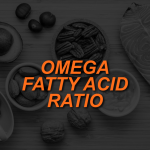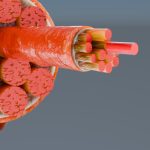Jumping athletes, particularly women, are prone to patellar tendonitis. This condition occurs when the patellar tendon becomes inflamed and causes pain in the knee.
The inflamed tendon inhibits proper movement of the patella during knee extension and flexion. The reason this happens varies greatly from person to person, but in most cases it is related to muscle weakness, tightness and overuse.
It is important to look at the entire kinetic chain when assessing the cause. A dysfunctional hip or ankle joint will disrupt proper movement patterns and place excess force on the knee. Athletes with tendonitis will be forced to compensate during jumping movements, which can actually place more force on the knee when landing. Athletes will experience more pain upon landing because the reactive force during landing is greater than take off. There is debate about whether the condition is caused by the jumping or landing mechanisms. It is more likely that the tendon is stressed more during the landing phase, as it is a decelerating phase, which ”loads the tendon beyond its inherent tensile strength” (Hammer, 2007).
Many practitioners will tell you to simply rest and stop playing sports, which in some cases may actually cause more problems. There are many treatment options but it is important to take care of it right away. Ignoring the issue may lead to tendinosis which is a more severe, chronic condition caused by degenerative changes in the cellular structure and fiber orientation of the tendon.
Frequently, what is actually tendinosis is called tendonitis. Tendonitis is only the initial stage during which the tissue is inflamed. It is often acute, and is usually due to microtearing from trauma, although it can also result from repetitive overloading. Most cases of patellar “tendonitis” though, when examined pathologically, show no inflammation, but reveal degeneration, indicating tendinosis. It is important to determine the difference because they will be treated differently.
True tendonitis will be treated with more anti-inflammatory modalities and Kinesiotaping, while tendinosis will be treated with more aggressive manual therapy on the actual affected tendon. Both conditions’ treatments, though, should include aggressive manual work, such as Active Release Techniques, Graston, Fascial Manipulation, and PNF stretching on surrounding areas, mainly hip and ankle, in order to restore balance and function. These techniques will help the tissue to heal much more efficiently, promoting proper fiber alignment and therefore better function.
Stability exercises, stretching, foam rolling and then progressing to strengthening are the best remedies. Concentric and eccentric strengthening of the quadriceps, especially the VMO, and also the anterior compartment muscles (tibials anterior, extensor hallucis longus and extensor digitorum longus) is important. (Hammer, 2007).
We recommend starting out easy with simple stretches for the entire leg and static exercises that do not cause pain. These conditions will not heal on their own and will usually worsen with time, and can lead to problems in other areas from compensatory patterns and imbalances. It is essential to address it as soon as possible for the best results.
There is no cookie-cutter remedy to treat the condition but there are a few standard exercises and stretches we included to help prevent and treat it. We recommend you get a full movement screening to identify the cause of your dysfunction and confirm if you actually have patellar tendonitis and not something more serious.
References:
1. Open Orthop J. 2012;6:553-7. doi: 10.2174/1874325001206010553. Epub 2012 Nov 30.
2. J Sports Sci. 2012;30(11):1157-63. doi: 10.1080/02640414.2012.695080. Epub 2012 Jul 4.
3. Acta Med Iran. 2011;49(3):169-72.
4.
5. Hammer, W. Functional Soft-Tissue Examination and Treatment by Manual Methods, Third Edition. Jones and Bartlett Publishers. Massachusetts, 2007
About the Authors
Charles DeFrancesco is the owner of the education program at Westchester Sports and Wellness (www.fitandfunctional.com). He is also a consultant for Pure Fitness Group, LLC and Fit and Functional, LLC. He is certified by the National Academy of Sports Medicine (NASM) and by the National Federation of Professional Trainers (NFPT). He is also USAW Olympic lifting certified and Equinox Fitness Group Prenatal certified. Charles has completed specialty courses for Functional Exercise Specialist, Cardiac Conditions (AFPA), attended EFTI, and has over 5,000 hours of clinical experience. He is the NFPT workshop coordinator for the Northeast region, and currently sits on the NFPT Board of Education. He is also a board member of the Ethics and Safety Compliance Standard for personal trainers. Charles is the main author of the Principles of Functional Exercise manual and A Squash Player’s Training Handbook.
Dr. Robert Inesta is a Certified Chiropractic Sports Practitioner and a Certified Strength and Conditioning Specialist. His extensive post graduate training consists of functional rehabilitation, functional soft tissue therapy and biomechanics, clinical neurophysiology and electrodiagnosis and nutrition. He is a certified provider of Active Release Techniques, Graston Technique and Kinesiotaping. Dr. Inesta’s main goal is to help his patients to reach their goals in the most efficient and effective way. He has lectured on topics including sports medicine, functional training, biomechanics, injury prevention and nutrition and has co-authored articles on functional training. He is also a co-author of the training manuals of the National Federation of Professional Trainers.






